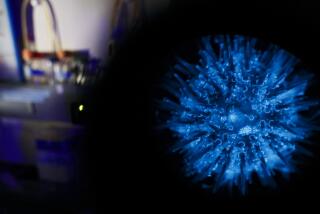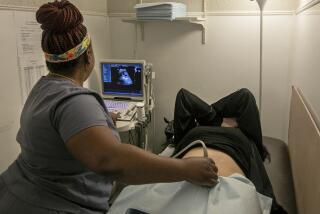THE SUNDAY PROFILE : Genetic Testing: Can We Know Too Much? : UC Irvine Professor Foresees Ethical Dilemmas as It Becomes Easier to Predict Birth Defects, Behavioral Problems
- Share via
To UC Irvine Prof. John J. Wasmuth, it is not speculation. It is a certainty.
Three years from now a woman who suspects she is pregnant will go to her physician for tests. The physician will scrape a few cells from the 10-week-old fetus and send them off for genetic analysis. It will be routine; the results will come back in only a few days.
The baby will be male. He will not have any of the more common, catastrophic birth defects. So far, so good.
He will be prone to colon cancer in midlife. That’s good to know. We can watch for that and treat it.
And he will be 20 times more likely to be severely schizophrenic or psychotic before he’s 20 years old. We can’t say it will happen, only that it is much more likely to happen.
Does the woman abort?
This is social dynamite, and the fuse is already burning. Though genes that cause disease are being discovered, on average, about once a month, that rate will accelerate rapidly, Wasmuth says. Yet measures to prevent or treat these disorders will lag many years behind.
Although Wasmuth, a professor of biological chemistry, has worked more than a decade to discover or help discover these genetic defects and the simple tests to diagnose them, he says he knows that gene testing can lead-- will lead--parents into agonizing dilemmas.
* Aborting a child certain to die within a few months of birth may not seem a difficult decision to some, but what about a child with a 50-50 chance of a life made miserable by incurable disease?
* What about a healthy, mentally intact child who will suffer from society’s prejudice? Dwarfism can be detected now in fetuses, and some researchers speculate that detecting the tendency toward homosexuality may be in store.
* More than diseases will be discerned from gene analysis. The genes controlling intelligence and body size will be discovered sooner or later. Will some parents abort children too small for football or too dim for college?
Wasmuth says he has seen the effects of such discoveries on others and on his own family.
After locating the gene that causes the most common form of dwarfism, he discovered a case in which a dwarf wanted his pregnant wife to be tested. If the child was not going to be a dwarf, the father wanted an abortion.
“He wanted a ‘normal’ child, and to him, a dwarf is normal,” Wasmuth says. “This is just the other side of the coin. These are not simple issues.”
And they are very emotional, too, as Wasmuth discovered when his daughter became pregnant last year. Early ultrasound tests showed something in the fetus that might indicate a mind-destroying defect. Gene tests would settle the question, and Wasmuth’s daughter sought his advice.
Wasmuth, to his surprise, advised against testing.
“To anyone else, I’d have said: ‘It’s the smart thing to do. Have the test. You can rule out the disease, at least.
“But this was my daughter, and it was very scary,” Wasmuth says. “I’d been doing this research for 15 or 20 years, and now it was like it brought my daughter down into my world. It was right in my face.
“My first inclination was, ‘The chances of this happening are so slim, don’t worry about it. Forget about it.’ I admit, it was a backwards reaction on my part, but this was my daughter.”
But his 28-year-old daughter, Michele Bones, a computer programming instructor, came from her home in San Diego to UCI for the gene tests, “and we had to wait for two weeks. She handled it better than I did; I was a basket case.”
The tests proved negative, and Wasmuth’s perfectly normal grandson was born in November. But he concedes that “this influenced me more than anything else.”
Now, Wasmuth says, he’s worried about how the discoveries he and other genetics researchers are making might be misused.
“Once you find the mutation that causes the genetic disorder and you put the information out there, people can use it any way they want, and I guess that’s what bothers me. You hope it will be used to the benefit of everyone, but you know that certainly is not always going to be the case.
“We haven’t been very good at long-range planning, have we? We had no idea of the implications of splitting the atom. Now we can have the information that would allow us to substitute our personal selection for natural selection.
“What should be tested for, and should we test everybody? If we test everybody, what disease do you eliminate through abortion and what disease do you sort of just let alone and say let natural evolution take its course? We may be really changing the evolution of the entire species in some way we don’t understand. That’s a little far-fetched in some cases, but I think in a lot of cases it’s not out of the question.”
Cystic fibrosis is a powerful example, Wasmuth says. The disease, produced when a child gets a defective gene from each parent, affects the lungs and is invariably fatal, usually before age 12.
“Natural selection always has, and probably always will, select out such a catastrophic defect. If it did nothing good, you’d expect it to be gone forever by now. But it’s not; it’s amazingly common. One in every 20 Caucasians carries it.
“So there’s a good possibility that this gene is involved in something beneficial that we don’t know about. Personally, I believe the disease is a side effect of something else, something important, that we haven’t found out about yet.
“It seems obvious at first--just get rid of this horrible defective gene--but I’m worried that we won’t have the insight to manage such things wisely.”
For the power to reach into human genes and change them “is not that far off,” Wasmuth says. “It can be done in mice right now. If it can be done in mice, it won’t be too long before it can be done in humans. Ethically and legally it’s not going to happen for a long time, but technically it could be done fairly soon.”
These are relatively new worries for Wasmuth, he concedes. “When I first started, I hadn’t even considered it.”
He started in Greenville, a small farming community in southern Illinois. Born in 1946 to a grocer and a registered nurse, he developed a passion in high school for sports and science. They turned out to have more in common than he thought.
“In science, being competitive makes a lot of difference,” he says. “It’s a competitive world, more than most. No one ever remembers who made a discovery second.”
No one in Wasmuth’s family had ever earned a college degree. “The people I knew there either didn’t go to college and stayed in town or they went to college and didn’t come back.”
Wasmuth joined the latter group and set off for Southern Illinois University with medical school in mind. The path led through Purdue University and the Baylor College of Medicine, where a genetics professor took Wasmuth under his wing. Not surprisingly, medical school was eclipsed by an increasing interest in the clinical aspects of genetics, Wasmuth says.
By then he had married Judy Schwierjohn, “a real, bona fide German. Her parents were farmers in Illinois, and we had been high school sweethearts.” They have been married 30 years and now live in a large house overlooking Lake Mission Viejo. His wife works for a firm that auctions real estate.
His introduction to genetics at Baylor changed his life, Wasmuth says. Until then he had envisioned a teaching career “at some reasonably sized college. It would be a nice, sedate way to make a living, I thought. But the more I got into genetics, the more I liked research, and that means a high-powered university.”
In 1977, Wasmuth was hired at UC Irvine to teach biochemistry to first-year medical students and to conduct the research of his choosing. “I’m really not sure how I wound up here, but once I got here, everything really sort of fell into place. UCI was a good career move. There was not much genetics being done here.”
Wasmuth began basic genetics research, shifting in the 1980s to intensive research into gene defects that cause disease. In 1993, he established UCI as one of the 16 universities with a Human Genome Center, a part of the National Institutes of Health’s long-term effort to map the location and purpose of every human gene.
It’s a monumental task, Wasmuth says, “probably the most difficult yet most interesting thing in biology.” It appeals to him, he says, for the same reason mystery stories appeal to him. “You have clues all along the way, and you really have to think about them. To me, this is just the biggest mystery of all.”
Gene-mapping is literally code-breaking, for the string of molecules in a gene is eerily like computer code. No one knows the method this genetic code uses to instruct its cell in how to form and what to do, but the code itself can be read. Laboratory equipment can take sections of genes and print out their sequences as a string of letters.
The genetic alphabet has only four letters--A, C, G and T--each representing one of the four kinds of coding molecules. The sequence carries the meaning. Just as ..- means U but -.. means D in Morse code, A-T-G means this is the beginning of a gene sequence but T-A-A means this is the end. What lies between may be a string of 1,000 molecules, but it may also be as many as 1 million.
There are 3 billion coding molecules in a complete set of human genes, and just one misplaced molecule can cause immense changes in human development. Researchers like Wasmuth search for that molecule by meticulously comparing the genes of afflicted people with the genes of normal people. Find the sequence in all the afflicted that is never seen in the normal, and you’ve solved the mystery.
You have also laid a foundation for future research, for if your gene causes, say, dwarfism, it must be in a gene that affects bone growth. Those seeking the genes for other genetically induced bone disorders are sure to search that region once your results are published.
This is the reason the pace of discoveries is accelerating, Wasmuth says. Disease-causing genes are being discovered about once a month now, but the rate could easily reach once a week by 1999. The pace will probably slow as the causes of more complex, multi-gene disorders are sought, he says.
Theoretically, every aspect of human physical development could eventually be determined by examining the genes of a person born or unborn. But practically, how much do people want to know?
A decade ago, people with a family history of Huntington’s disease, a disorder that sets in at midlife and slowly drags its victim toward dementia and death, were asked if they would like to be tested for the disease if a test were available. About three in four said yes, Wasmuth says. Yet when a test became available, enthusiasm waned. About half said they did not want to be tested.
“When it is sort of a theoretical thing, people say, ‘Sure, I’d do it, “‘ Wasmuth says. “But when it’s time to sit down and do it--you’re 35 and we’re going to test you to see whether you have 10 instead of maybe 40 good years left--well, you just don’t know what you’ll say until you’re there. Is ignorance bliss?”
And knowledge will be even more painful when it is not certain, Wasmuth says. Most reports will not be yes or no with 100% certainty. They will be probabilities, like odds in a casino--one chance in five that your baby will be a lifetime burden rather than a blessing.
“I think uncertain answers will cause more anxiety than no answers at all. Having an uncertain answer and the option to abort? Right now people say no, I don’t want to know. It happens.
“I know a lot of people who had a prenatal diagnosis where the child clearly was going to have Down’s syndrome and they go ahead. They wanted the child, and they have the child. Others abort. Neither one can understand the other one. It’s a very personal decision, and no one can make the decision for anybody else.”
Wasmuth was raised a Catholic, a religion dead set against abortion, but he says he has modified his thinking and is no longer a practicing Catholic. “But it’s something you don’t get rid of, and so I think about all this in that context also. But for me, this is apart from religion or anything else. It’s sort of like how I view things.
“Imagine someone who grew up in a teeny, tiny town in southern Illinois who can actually find something abnormal in genes and develop a test for it. In some ways it’s a little bit frightening, because you don’t exactly know 10 years from now how the information will be used.
“But in the long run, it does much more good than harm. Finding the defective gene is the first step to preventing or curing the disease. I’m not going to quit what I do. It’s too important, and I love doing it.”
John Jacob Wasmuth
Age: 48.
Background: Born in Greenville, Ill., now lives in Mission Viejo.
Family: Married 30 years to Judy Schwierjohn, with whom he has a 28-year-old daughter, Michele Bones of San Diego, and a grandson, Connor, 10 months.
Passions: Mystery stories, any sport and breaking genetic codes.
On the simplicity of genetic testing: “The test for achondroplasia (a form of dwarfism) can be done by a high school biology lab with one piece of equipment and $100 worth of chemicals. Four reasonably intelligent high school students could do 100 tests in a month. Tests aren’t all that simple, but a lot of them are, and they’re getting simpler all the time.”
On the future of genetic repair: “For the most part we’re still playing with Tinkertoys, but for the last five or six years people have been able to stick genes into mouse embryos and correct genetic defects. If you can do it in mice, you can do it in people. It’s just a matter of not being efficient enough at this time.”
On genetic discoveries: “Once you get familiar with the playing field, with human genes, a lot is intuition. You see something, but it may not hit you that day. Maybe two weeks later you’re thinking, ‘Something about that bothers me.’ But sometimes it’s a genuine, all-out aha!”






